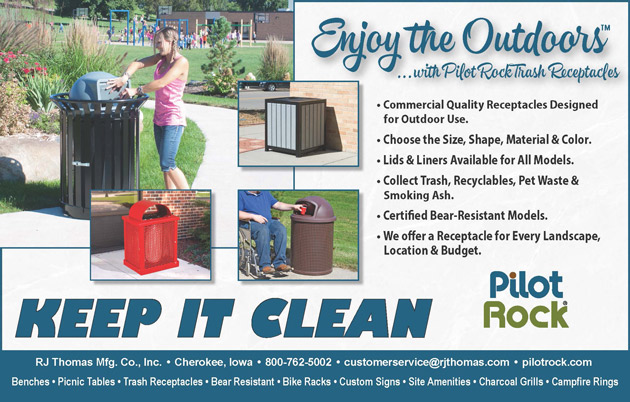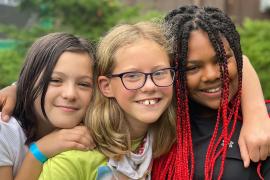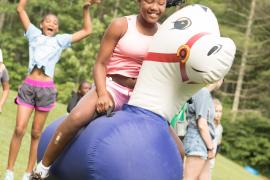"We're all girls here! You shouldn't be embarrassed!"
But, oh my, was I embarrassed! I couldn’t even begin to name all the ways I felt embarrassment and shame in girls’ bathrooms, changing areas, and cabins. Looking back now, it’s still hard to determine how much of my discomfort was caused by being fat, being attracted to girls, feeling like I wasn’t a girl, or the constant questioning of where everyone else thought I belonged. Even when there was one stall I could wait in line for, that didn’t mean everyone else changing around me made me panic any less.
Like many other transgender (Trans*; an umbrella term that refers to many different identities within the gender identity spectrum) people, I eventually stopped using public bathrooms altogether, even at school. I knew if I didn’t eat or drink anything all day, I wouldn’t have to use the bathroom and could avoid causing a scene when someone perceived me as being in the “wrong bathroom.” My grades dropped. I skipped field trips and overnights. I even quit softball after 10 years when faced with zero-privacy locker rooms. I couldn’t answer honestly when asked why, because I’d have to answer that I liked girls and/or that I wasn’t one — not safe options in a rural, religious community. It wasn’t until much later that I realized you don’t have to be Queer, or an adult, to want or deserve privacy and to feel safe.
My first inclusive camp experience didn’t happen until I was in my mid-20s when I volunteered at a Camp Fire weekend retreat. At a campground outside a rural Oklahoma town, surrounded by LGBTQ2S+ (Lesbian, Gay, Bisexual, Transgender, Queer, Two-Spirit) young people and adults, I finally had the chance to experience an overnight adventure without fear. Cabin assignments were made by age, not gender. Bathroom and shower facilities were not only open to all genders, but they were always monitored and made to feel safe. Clear expectations and boundaries were set at the beginning of the session and reinforced throughout: We always used the Truddy system (groups of three or more), and an adult was always to know where a camper was. Beds were for sleeping only, one butt per bunk/one head per bed at all times. We respected each other’s privacy and valued safety, so we only changed clothes alone in designated private spaces and not openly in front of others. We respected each other’s pronouns.
I was the adult in this situation, and this was all very new to me, but nothing had ever made more sense. I suddenly was shocked at how lacking the general safety and oversight had been in all the programs I was in as a young person, strictly because of the “we’re all girls here” ideology.
Each cabin at this camp had a private toilet room with sinks and mirrors just outside. Staff were strategically placed by the door into the bathroom and at the door leading outside to monitor spaces where privacy might be available for inappropriate behavior. Shower hours were staggered so that cabins went as units with staff supervision, but individual shower times were also made available for youth and staff who needed or wanted total privacy or longer times. Youth were encouraged to be their full authentic selves and were committed to protecting each other’s identities outside of that space — because they understood the danger some of them would face at home if people knew they were Queer. Physical privacy and privacy of information were both clear priorities.
In 2018 I was hired as the diversity, equity, and inclusion program manager at Camp Fire Green Country and given the opportunity to host Oklahoma’s first-ever LGBTQ2S+ specific summer camp session. Building on the best practices I had observed through years of volunteering at LGBTQ2S+ specific weekend retreats and feedback from youth I was connected to through local support groups and Gay Straight Alliance/Equality clubs, we got to work. We had an outpouring of support. Calls came from adults asking how they could contribute, wanting to know if we offered the same camp for adults who had wished for something like this as youth. Local businesses sent donations for scholarships.
Of course, there were calls from concerned parents who wanted to know, “What will you be teaching my child?” and “How do gender neutral cabins work?” among other questions.
I knew it was important to talk through fears that families had, so leading up to camp I connected with parents/caretakers to help them feel comfortable. “This is just camp,” I assured them, “nothing particularly ‘Queer’ about it. Same activities: kayaking, rappelling, swimming, talent show — but your child won’t be alone. They won’t be the only one swimming in a binder (or other gender-affirming clothing), or ever be put in the ‘wrong place’ because all of our space is for everyone.”
The goal was to create an environment where LGBTQ2S+ youth could be themselves, build relationships, and have fun. Centering on safety and ensuring camper-staff ratios allowed for adequate supervision, which was paramount to our success and to gaining parent/caretaker trust.
In 2019 I was hired at Camp Fire National Headquarters to expand access to summer overnight camp to LGBTQ2S+ young people, young people with disabilities, and young people from lower socioeconomic backgrounds through a Camp Accessibility, Meaningful Participation, and Equal Representation initiative (C.A.M.P.E.R). The first year of the initiative was used to collect as much information as we could about what all of our stakeholders needed in order to feel safe, supported, and affirmed at Camp Fire. Ten Camp Fire summer camps were selected as part of a cohort to be observed and improvement plans put in place. That year we surveyed 398 young people, 355 parents, and 213 staff members; we also conducted in-person focus groups with 142 youth across the 10 camps. A few main themes came out of this data that affected all youth, not just those who are LGBTQ2S+: Privacy and accessibility were the top two.
Personal Privacy
Every person deserves physical privacy, but young people are often not allowed to experience this. Adults often make assumptions. “We’re all the same here, just change clothes and don’t feel weird.” But that’s not reality for most people, regardless of their gender or sexuality — and young people are no exception.
Camp Fire survey results showed the most requested spaces for privacy were changing spaces, bathrooms, and showers. Young people and staff alike requested solid stalls with locking doors over shower curtain dividers. Pop-up privacy tents became a solution for providing additional changing spaces in cabins and near the waterfront. Some scheduling changes were needed to ease congestion in private spaces, such as providing additional time for changing.
When you provide adequate personal privacy and staff supervision, there is no reason why gender-neutral cabins and bathrooms should not be an option. A 2016 study by the J Walter Thompson Innovation Group found that more than half of American young people identified as something other than “exclusively heterosexual” (Teller, 2017). If you’re concerned about inappropriate behavior, keep that statistic in mind. We’ve historically acted as though keeping “boys and girls” separated meant no funny business or “purpling” as camp folks say. The fact is girls like girls and boys like boys — and not all of our youth are either one or the other, or interested exclusively in one gender. “We’re all girls/boys here” was never true and is certainly not enough to keep young people (or staff) feeling safe and affirmed today.
Private Information
Privacy of personal information was of particular concern to our stakeholders, especially young people. Campers wanted to know that their information was safe with staff who they felt comfortable sharing with.
We have implemented staff training resources that address how to protect camper personal information, from birth names to what to do when a young person comes out to a staff person at camp. We know from research conducted in large part by The Trevor Project (a national organization providing crisis intervention and suicide prevention services to lesbian, gay, bisexual, transgender, queer, and questioning (LGBTQ) young people under 25) that LGBTQ2S+ young people experience homelessness, self-harm, and suicidality at disproportionate rates compared to other youth (The Trevor Project, 2020, 2021). Some contributing factors are social stigma; being abused, kicked out, or disowned by family; and lacking supportive adults.
Your staff must be trained and know they are not required to, nor should they ever disclose a young person’s gender or sexuality to their parents/caregivers (or anyone else for that matter.) This includes sharing that a young person uses a different name and pronouns at camp than they do at home. If you have not been given explicit permission to share that information by the young person, do not share it. You are putting them at risk for backlash, including abuse and homelessness.
People often stop me here and ask, “What about mandatory reporting?” No identity requires reporting. Period. If young people disclose that they are a threat to themselves, someone else, or are being abused, those should all be reported as usual, but simply being LGBTQ2S+ does not equate to risk or danger. Talk to the young person about who knows their identity, who cannot know, and how they need you to protect their information. If they have not told their parents/caregivers, I promise there is a reason, and not you nor anyone else has the right to take away their ability to protect themselves.
I highly recommend The Safe Zone Project’s (thesafezoneproject.com/) training kit available for free online to get started. They have excellent resources concerning what you should and should not do when a young person comes out to you, as well as facilitation guides for training staff and volunteers.
Accessibility
Finally, if there is not a bathroom, cabin, or shower that Trans* and nonbinary people can use comfortably, your camp is not accessible to them. It’s not impossible, but certainly not safe for anyone to go a week or more without eating, drinking, using the bathroom, changing, sleeping, or showering at camp. (Believe me, I tried in seventh grade, and it wasn’t fun for anyone.) These are basic human functions that all people need access to in order to survive.
You don’t need a special bathroom for transgender people; toilets are toilets. With intentional scheduling, supervision, privacy, and a quick sign change, any bathroom can be used by all genders safely. Do not segregate Trans* youth. This places their identities first and forces them to be out to everyone in that space. Segregation does not equal accessibility, and it can easily lead to increased harassment and bullying. Speaking of bullying, do you have specific anti-bullying and harassment policies that explicitly protect LGBTQ2S+ young people and staff? You should. When implementing any new features or policies, be sure to explain why and what measures you’re taking to ensure safety to campers, staff, parents, and caregivers.
I’ll leave you with the story of “Cole,” a young trans man. Cole’s mom and I had connected prior to camp, and she shared some concerns about camp being outdoors in July, because Cole wore a hoodie everywhere, at all times. I assured her that we had plenty of air-conditioned space, that Cole could always choose alternate activities, and that we would monitor him regularly to make sure he didn’t overheat. As promised, Cole arrived at camp in a heavy black hoodie and black jeans. I overheard a camper ask if he was hot, but he shook his head and went back to sketching. On day two I spotted Cole walking to the dining hall. His sleeves were gone. He had taken scissors and cut the sleeves of his sweatshirt off at the elbow. After briefly wondering, “Is mom going to be mad?” I realized it didn’t matter. Cole was starting to feel comfortable, and that’s what was important. By the end of the day, Cole had chopped his sleeves off at the shoulder and his jeans off at the knee. He had a posse of new friends with whom he was already planning shopping and outdoor adventures when they returned home.
Cole had to leave camp early to get to a family function, and his mom came to pick him up. As she crossed the parking lot to meet us, a gaggle of glittery teens surrounded Cole and showered him with hugs, all saying, “You’d better call me!”
As they said their goodbyes, Cole’s mom pulled me aside. She was crying. “I haven’t seen his arms and legs like this in years. He hasn’t been swimming since he was little. What happened?”
Cole was able to do things with his new friends that he hadn’t been able to do alone. He had seen himself represented in the adult Trans* staff members and gained confidence. His mom told me they were taking a beach vacation soon and she had been worried about what he would do. I shared resources for where to find gender-affirming swimwear, and weeks later she posted a photo of Cole on the beach with his family, something she thought would never happen. This wasn’t just camp — this was life-changing authenticity in action.
I know that many of these shifts feel daunting, even impossible, but they aren’t. We have a responsibility as youth workers to ensure every young person in our care feels safe, supported, and affirmed. You don’t have to do it alone. Feel free to contact us at Camp Fire National Headquarters (campfire.org/resources) to learn about our process, trainings, and potential partnerships.
About Camp Fire
Camp Fire was America’s first multiracial, multicultural, and nonsectarian organization for girls. In 1975, it became coed and welcomed all youth. In 1993, Camp Fire officially added sexual orientation to its inclusion policy.
According to its official Statement of Inclusion, “Camp Fire believes in the dignity and the intrinsic worth of every human being. We welcome, affirm, and support young people and adults of all abilities and disabilities, experiences, races, ethnicities, socioeconomic backgrounds, sexual orientations, gender identities and expressions, religion and nonreligion, citizenship and immigration status, and any other category people use to define themselves or others.”
Photo courtesy of Brave Trails, Los Angeles, CA.
Ben Matthews (they/them) is a diversity, equity, and inclusion specialist at Camp Fire National Headquarters. They can be reached at [email protected].
References
Camp Fire National Headquarters. (2021). The experience. Retrieved from campfire.org/experience/
Teller, D. (2017, May 3). The coming z-change. Psychology Today. Retrieved from psychologytoday.com/us/blog/tipping-sacred-cows/201705/the-coming-z-change
The Trevor Project. (2021). National survey on LGBTQ youth mental health 2021. Retrieved from thetrevorproject.org/survey-2021/
The Trevor Project. (2020). National survey on LGBTQ youth mental health 2020. Retrieved from thetrevorproject.org/survey-2020/




